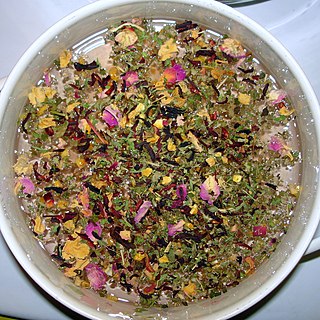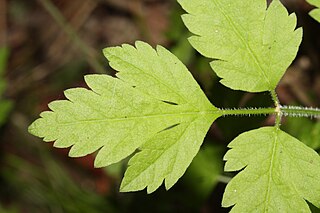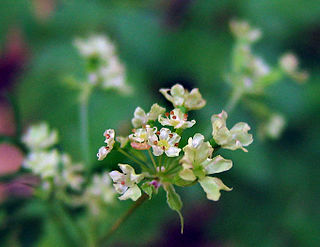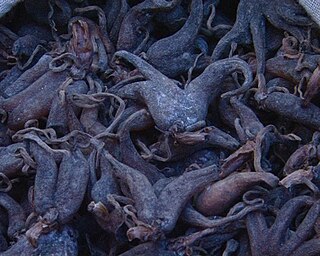
Herbal teas, also known as herbal infusions and less commonly called tisanes, are beverages made from the infusion or decoction of herbs, spices, or other plant material in hot water. Oftentimes herb tea, or the plain term tea, is used as a reference to all sorts of herbal teas. Many herbs are used in herbal medicine. Some herbal blends contain actual tea.

A bitters is traditionally an alcoholic preparation flavored with botanical matter for a bitter or bittersweet flavor. Originally, numerous longstanding brands of bitters were developed as patent medicines, but now are sold as digestifs, sometimes with herbal properties, and as cocktail flavorings.

Myrrhis odorata, with common names cicely, sweet cicely, myrrh, garden myrrh, and sweet chervil, is a herbaceous perennial plant belonging to the celery family Apiaceae. It is the only species in the genus Myrrhis.
Sweet cicely is a common name for several plants and may refer to:

Veratrum is a genus of flowering plants in the family Melanthiaceae. It occurs in damp habitats across much of temperate and subarctic Europe, Asia, and North America.

Abutilon indicum is a small shrub in the family Malvaceae, native to tropical and subtropical regions. This plant is a valuable medicinal and ornamental plant, its roots and leaves being used for curing fevers. It has been widely introduced outside of its native range, and is considered invasive on certain tropical islands.

Hebanthe erianthos, known as suma or Brazilian ginseng, is a species of plant in the family Amaranthaceae. The specific epithet is also spelt "eriantha", although the basionym is Iresine erianthos.

Viburnum prunifolium is a species of Viburnum native to eastern North America, from Connecticut west to eastern Kansas, and south to Alabama and Texas.

In general use, herbs are a widely distributed and widespread group of plants, excluding vegetables and other plants consumed for macronutrients, with savory or aromatic properties that are used for flavoring and garnishing food, for medicinal purposes, or for fragrances. Culinary use typically distinguishes herbs from spices. Herbs generally refers to the leafy green or flowering parts of a plant, while spices are usually dried and produced from other parts of the plant, including seeds, bark, roots and fruits.

Osmorhiza berteroi is a species of flowering plant in the family Apiaceae known by the common name mountain sweet cicely.

Osmorhiza brachypoda is a species of flowering plant in the family Apiaceae known by the common name California sweetcicely.

Osmorhiza depauperata is a species of flowering plant in the carrot family known by the common names bluntseed sweetroot and blunt-fruited sweet-cicely.

Osmorhiza occidentalis is a species of flowering plant in the family Apiaceae known by the common name western sweet cicely or western sweetroot.

Osmorhiza longistylis, commonly called long-styled sweet-cicely or longstyle sweetroot, is an herbaceous plant in the family Apiaceae. It is native to North America, where it is found from the Rocky Mountains east to the Atlantic Coast, in Canada and the United States. Its natural habitat is in forests with fertile soil, often in areas of loam and dappled sunlight. It can be found in areas of high or average quality natural communities, and does not tolerate intense disturbance.

Frasera caroliniensis, commonly known as American columbo or yellow gentian, is a herbaceous perennial of the gentian family Gentianaceae found in the deciduous forest of Southern Ontario and throughout the eastern and southeastern United States. It was previously known as Swertia caroliniensis.

Smilax aristolochiifolia, also known as gray sarsaparilla, Mexican sarsaparilla, sarsaparilla, is a species in the genus Smilax and the family Smilacaceae, native to Mexico and Central America. It is widely used as traditional medicine to treat many symptoms.

Dactylorhiza hatagirea is a species of orchid generally found growing in the Himalayas, from Pakistan to SE Tibet, at altitudes of 2,800–4,000 metres (9,200–13,100 ft). It is locally called 'salam panja' or 'hatta haddi'. It is called 'panchaule' (पाँचऔंले) in Nepali and Himalayan regions. The name 'panchaule' arises from its root resembling fingers of hand with around 3-5 fingers. It is an erect perennial herb with long flowering stems. The plant is well known for its medicinal value. The root has sweet taste. It is strictly prohibited for collection and sale, but can be found easily around Nepal. It costs around NRs. 10,000-15,000 per kilo as of late 2015.
This is a list of plants used by the indigenous people of North America. For lists pertaining specifically to the Cherokee, Iroquois, Navajo, and Zuni, see Cherokee ethnobotany, Iroquois ethnobotany, Navajo ethnobotany, and Zuni ethnobotany.
















